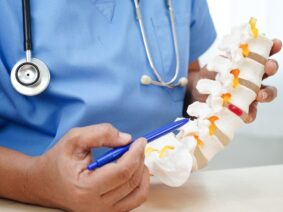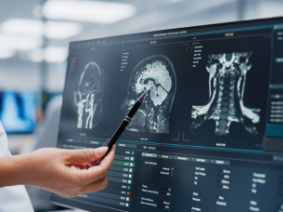Oligodendroglioma
Oligodendroglioma is a type of rare tumor that develops in the brain or spinal cord from glial cells (a type of brain cell) called oligodendrocytes. These cells help protect nerves. It occurs most often in the frontal or temporal lobes of the brain.
Oligodendrogliomas progress gradually, which gives patients a longer survival time. Though the tumor can occur in children, it is most common in adult men and women, typically over the age of 40. Treatment depends on the grade of the tumor. Regardless of treatment, there is a high oligodendroglioma recurrence rate.
There are three types of oligodendroglioma:
- Grade 2 oligodendroglioma (low grade). A benign (noncancerous) tumor, an oligodendroglioma is slow growing and can continue to grow for years before symptoms appear. This tumor typically affects only nearby tissue and does not spread (metastasize); however, Grade 3, fast growing, oligodendrogliomas are possible and require more aggressive treatment.
- Grade 2 oligoastrocytoma (low grade). This benign tumor is a “mixed glioma” tumor. Astrocytoma is another type of glioma (brain) tumor that develops from astrocyte glial cells. Oligoastrocytomas contain both abnormal oligodendroglioma and astrocytoma cells and may evolve into malignant (cancerous) anaplastic oligoastrocytomas.
- Grade 3 anaplastic oligodendroglioma (high grade). This malignant (cancerous) tumor is fast growing and can rapidly spread to other areas of the body’s central nervous system (CNS). It requires aggressive treatment.
- Grade 3 anaplastic oligoastrocytoma (high grade). The malignant form of this mixed glioma occurs when abnormal astrocyte cells mix with abnormal oligodendrocyte cells to form an anaplastic oligoastrocytoma. This type of tumor is fast growing and can rapidly spread to other parts of the CNS, requiring aggressive treatment.
Causes and Risk Factors
The cause of oligodendroglioma is still unknown, though certain risk factors exist:
- Age. Though a brain tumor may occur at any age, the risk rises as people age.
- Exposure to radiation. Examples of ionizing radiation include exposure caused by nuclear weapons and the radiation therapy used to treat cancer.
- Family history of glioma. Though a hereditary factor is rare, having a family history of a glioma can double a person’s risk.
Symptoms
Symptoms of oligodendroglioma vary by location in the brain, size and type or grade of the tumor. In earlier stages, oligodendroglioma symptoms can be misdiagnosed as a stroke. Further tumor progression that causes more symptoms is often what causes the correct diagnosis.
The most common symptoms of oligodendroglioma are:
- Seizures
- Headaches
- Personality changes
If located in the frontal lobe of the brain, oligodendroglioma may cause:
- Weakness on one side of the body
- Behavior changes and cognitive problems, such as memory loss
- Vision loss
- Paralysis
If the tumor is located in the temporal lobe, there are often no or very few symptoms, with the rare, but possible chance of seizures or language problems.
Diagnosis
Tests and procedures used to diagnose oligodendroglioma include:
- A neurological exam looks for clues about if a tumor might exist and which part of the brain may be affected.
- Imaging tests help determine the location and size of the brain tumor. Different types of magnetic resonance imaging (MRI) tests are often used to diagnose brain tumors. Other imaging tests may include computed tomography (CT) and positron emission tomography (PET).
- A biopsy of the tumor or suspicious tissue is taken before surgery and sent to a lab to analyze the types of cells and how aggressive (fast spreading) the cells are. A biopsy is performed using a needle to remove a small sample of the affected tissue.
- Other specialized tests of the tumor cells provide important information about the types of mutations (changes) the tumor cells have undergone. This data provides helpful information used to provide a prognosis (outcome and course of disease) and guide treatment options.
Treatment Options
Surgery is the preferred treatment option for oligodendroglioma, if the tumor is in a surgically accessible area. A neurosurgeon removes as much of the tumor as possible while avoiding healthy brain tissue.
Additional treatments are often recommended after surgery if any tumor cells are unable to be removed and/or if a high risk exists for the tumor to grow back. Chemotherapy and radiation are often recommended after surgery to help prevent the tumor from returning. Regular MRI scans are recommended following a successful removal of low-grade oligodendrogliomas.
In the case of anaplastic oligodendroglioma, radiation and chemotherapy are typically used in combination. If the tumor is recurrent (comes back), surgery in combination with chemotherapy is often recommended.
Other treatments for oligodendroglioma include:
- Chemotherapy
- Radiation
- Clinical trials studying new treatments
New Treatments
- Targeted medication treatment focuses on specific abnormalities present in the cancer cells. An example is bevacizumab (Avastin), which is used to treat glioblastoma (brain cancer).
- Convection-enhanced delivery (CED) includes pumps that release a continuous flow of chemotherapy or targeted drug therapies to a tumor.
- Tumor-treating fields (Optune) deliver electric fields to the brain. These fields can help stop the growth of cancer cells. Optune is a portable, wearable device used in combination with the medication temozolomide to treat newly diagnosed glioblastoma in adults.
- Implanted, biodegradable wafer therapy (Gliadel) uses an implanted disc to release chemotherapy to leftover tumor tissue that is unable to be removed during surgery.
- Nanoparticle therapy utilizes particles with an unusually high surface area to carry chemotherapy across the blood-brain barrier and directly to the tumor.
Palliative (Supportive) Care
Palliative care focuses on relieving symptoms caused by the tumor, but is not a treatment. Palliative care specialists work to provide pain relief and relieving other symptoms as well as providing an extra support team that works alongside other members of the treatment team. Palliative care is often used during treatment, especially aggressive treatments, such as surgery, chemotherapy and radiation therapy.
Life Expectancy and Survival Rate After Treatment
Though completely eliminating the tumor or disease process is rare, oligodendroglioma has a higher brain cancer survival rate than most other brain tumors due to their slow growth and usually excellent response to treatment. Prolonging the life expectancy of someone with an oligodendroglioma is possible.
Life expectancy depends on the grade of the tumor, how early it is diagnosed, its location and individual factors, such as comorbidities (other disease conditions present). Life expectancy statistics are not predictive as they do not account for individual factors, such as overall health.
On average, people with a grade II oligodendroglioma are likely to live about 12 years after diagnosis. People with a grade III oligodendroglioma live an average of 3.5 years after diagnosis.
Rehabilitation
Quality of life after brain tumor treatment is greatly affected for the better by rehabilitation. Brain tumors affect parts of the brain that control motor skills, speech, vision and thinking. Rehabilitation is often a necessary part of recovery, such as:
- Physical therapy
- Occupational therapy
- Speech therapy
- Counseling
- Tutoring for school-age children
A brain tumor diagnosis can feel scary and overwhelming. The many emotions attached to this diagnosis can make dealing with treatment feel even more difficult. At Neurosurgical Associates of Central Jersey, we take care of the whole person, not just a diagnosis. We work with you as we establish the best treatment plan for your individual case and stay with you throughout your journey. Learn how our compassionate care can help you or a loved one by contacting us to make an appointment with one of our specialists.



